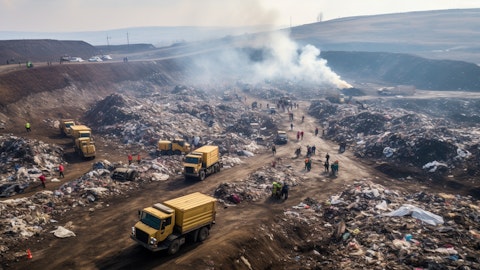And so what’s happening is we’re in the process of delivering a lot of that right now into Q2. So we do believe that Q2 for sure, we will deliver more Class A trucks. There’s just no question about it. The stuff’s on the ground already. We’re already almost through April. I’m pretty solid as to where we’re going to be in Q2. Now, we look into Q3 and Q4. Are there concerns? You better believe it. Is the backlog pretty far off? You better believe it. But you know what? We’re not an allocation anymore. You want a truck? I can start one for you in eight weeks or so. So it’s not like, I can still start a truck in the back half of Q2 to deliver to you in Q3 and Q4. So we feel pretty good about that. I do believe we’ll be softer. There’s no question in my mind.
I do believe the second half will be less Class A deliveries in the first half. Okay, like I said, Q2 more than Q1, the second half less than the first half. But given the diversification of our market, look, most all your big carriers have already placed all their orders for this year. The little guys, we’re still way oversupplied in trucks out there. Just look at contract rates, look at spot rates, it’ll tell you what’s going on. So that market is going to be tough. But given our diversification and the devocation that we sell into, we’re going to be extremely strong in refuse. That’s booked out. I already know where I’m at. I’m going to have more construction. Now we do have some supply issues from one transmission manufacturer we’re dealing with and some other things on the vocational side, but we still have the opportunity to sell into that.
And there are still some private carriers out there that are looking at purchases, right. Not for hire, but private stuff that we believe we can sell into, okay, so the year is not done. I’ll put our sales team out there and challenge anybody, and we’re going to be out there, we’re going to be looking for business, and there’s going to be some. It’s just not going to be what it has been until this freight recession clears itself up. Everybody’s got to remember, still over half the market is the over-the-road market. It isn’t other than, LTL is in good shape, but all those orders are pretty much placed. There are one or two little small ones out there we’re working on, but most of that business. So the second half is going to be tougher. But I believe that we end up the year, when you look at our total market, we will be in a lot better shape when you look at our ‘24 compared to what the US retail market went down in ‘24, given our diversification.
There’s just some timing stuff, but I do expect that as we get into the fourth quarter, you will start to see, let’s not get too short-sighted here, when we’re going to have good, we’re going to produce when it comes to the company, I promise you, just like I’ve answered a minute ago to Justin. I’m as solid as ever about where we’re at, but when we get into that last quarter, people will really start, I do believe you’re going to see the order of intake go up, and I do believe you’re going to see ‘25 and ‘26 as we’ve just finished passing the last greenhouse gas law just three weeks ago, and they’re pretty strenuous that are out there that folks are going to have to start focusing on. Right now, they’re at a lot of their own business, they’re focused on their own business currently, but they’re going to have to focus on their fleets and the makeup of their fleets and having to deal with all the new technology and the inflationary price increases to meet the demands that are going to be put on in January 1, ‘27.
So I would expect that those markets will regardless of the overall market, will understand they’re going to have to invest, not the small carrier so much, but the large carrier, regardless of where they are in their own business, hopefully the freight recession will be clearing up by the back half of this year, sometime in the third. Look, I’ve been watching everybody kick the can for a year about when freight was going to pick back up, so I’m not going to be in the economist here and tell you when, but I know it’s got to turn around sometime, but further we go, the closer we get to the end of it, you’ve got to believe, but then you tie that up with the ‘27 EPA laws, you’re going to start to get, I do believe ‘25 and ‘26 will still be the kind of years that everybody’s been predicting, because look, engine prices are going to go up 20,000 and plus dollars just for diesel and more when we get into ‘27, you’re going to have demands if you have to do this much electric, do this much of that.
So people are going to be a little nervous and fearful of that. So I do believe that will guide ‘25 to ‘26 to be super solid. We’ll just deal with ‘24, as I said, given the diversification, I’m comfortable. Will it be backwards in the first half? Yes. But we still got time to try to make it a little more decent. So there you go. I know I rambled on for a while, but I’m trying to give you a larger look at what we seek out in front of us for the next two and a half years.
Andrew Obin: Sure. And just, looking at the ACT forecast, which you referenced, what do you think it puts and takes with the ACT forecast? What do you think is potential upside to the numbers? And what do you think is potential source of the downside to the numbers?


